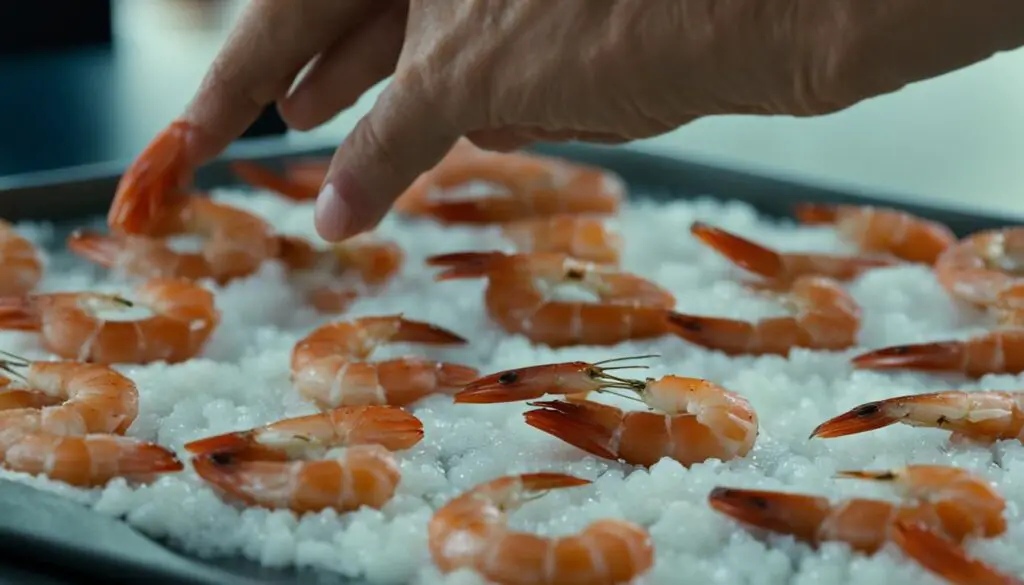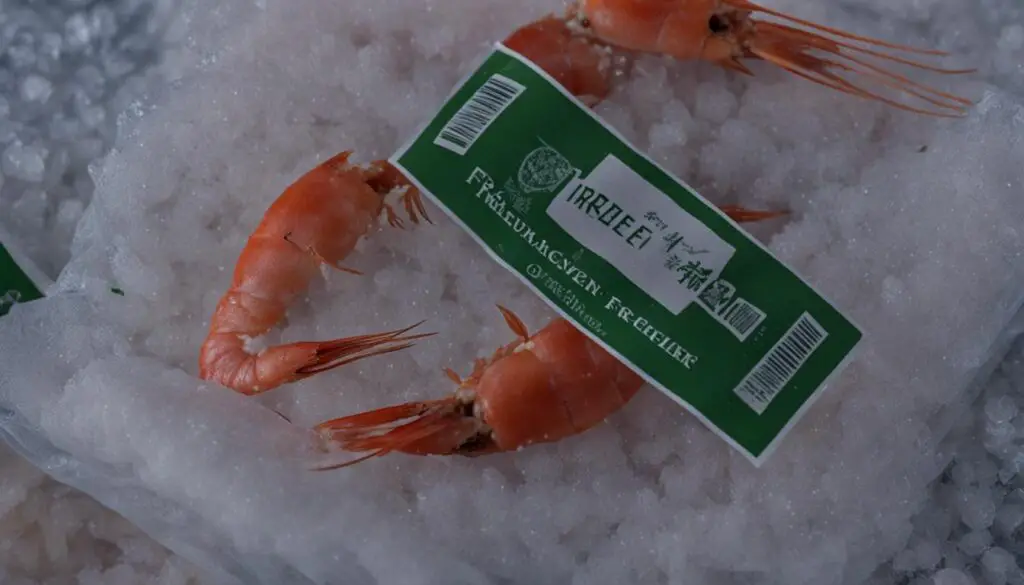When it comes to preserving the freshness of seafood, freezing is a common technique used by many. But can shrimp be frozen safely? The answer is yes! Freezing shrimp not only extends its shelf life but also ensures that it remains delicious and safe to consume. In this article, we will explore the proper techniques for freezing shrimp, from handling to thawing, to help you preserve the quality of this popular seafood.
Key Takeaways:
- Freezing shrimp is a reliable method to prolong its freshness and prevent spoilage.
- Proper handling, including limiting trawling time and washing hands, is essential before freezing shrimp.
- Techniques like using zip-top freezer bags or waxed milk cartons can ensure optimal freezing results.
- Thawing frozen shrimp either in the refrigerator or under cold, running water helps maintain its taste and texture.
- Other types of seafood, such as fish, crabs, and oysters, can also be safely frozen using specific handling and freezing techniques.
Proper Handling of Shrimp for Freezing
When it comes to freezing shrimp, proper handling is crucial. To ensure the best results and maintain the shrimp’s quality, it’s important to follow a few key steps.
Firstly, it is recommended to limit trawling time to reduce stress on the shrimp. This can help preserve the taste and texture of the shrimp when it’s frozen. Additionally, after emptying the trawl, it is important to shade the catch and sort it immediately to remove any unwanted by-catch. This ensures that only the best shrimp are selected for freezing.
When handling shrimp at home, it is necessary to wash and sanitize hands, the kitchen sink, and any other surfaces that will come in contact with the shrimp. This helps prevent cross-contamination and ensure that the shrimp remains safe to consume.
Another important aspect of handling shrimp for freezing is heading the shrimp before freezing. By removing the heads, it reduces the amount of ice and storage space required. This is especially useful for those with limited freezer space or those who want to maximize their storage capacity.
Leaving the shells on the shrimp tail meat is also recommended. This helps to reduce freezer burn during frozen storage, maintaining the flavor and moisture of the shrimp.
By following these proper handling techniques, you can ensure that your shrimp freezes well and maintains its quality during storage. The next section will discuss different freezing techniques for shrimp, allowing you to choose the method that suits your needs best.
Freezing Shrimp Techniques
When it comes to freezing shrimp, there are several techniques that you can use to ensure its freshness and quality. Here are a couple of methods that you can try at home:
-
Zip-Top Freezer Bag Method:
In this method, you will need a 1-quart zip-top freezer bag. Start by placing 1 pound of shrimp into the bag. Fill the bag with cool tap water, making sure that all the shrimp are covered. Then, carefully drain any excess water from the bag. Seal the bag tightly and place it in the freezer. The shrimp should freeze completely within a few hours.
-
Waxed Milk Carton Method:
For this method, you will need a half-gallon waxed milk carton. Begin by placing two pounds of shrimp into the carton. Fill the carton with cool tap water, ensuring that all the shrimp are submerged. Once the shrimp are added, seal the carton tightly. It’s important to note that you may need to add more water to cover any exposed shrimp after freezing. Once filled, place the carton in the freezer, and the shrimp will freeze solid within a few hours.
Using these freezing methods, your shrimp can be stored for 4 to 6 months without losing its quality and taste. The key is to ensure that the shrimp is properly sealed and protected from freezer burn.
Comparison of Freezing Methods
| Freezing Method | Required Supplies | Freezing Time | Storage Duration |
|---|---|---|---|
| Zip-Top Freezer Bag | 1-quart zip-top freezer bag | A few hours | 4 to 6 months |
| Waxed Milk Carton | Half-gallon waxed milk carton | A few hours | 4 to 6 months |
Note: Make sure to label the bags or cartons with the date of freezing to keep track of their freshness.

By following these techniques, you can now freeze shrimp at home with confidence. Proper freezing methods will help you preserve the freshness of your shrimp, so you can enjoy them whenever you desire.
Thawing and Cooking Frozen Shrimp
When it comes to using frozen shrimp, proper thawing is essential before cooking. Thawing methods can affect the texture and taste of the shrimp, so it’s important to follow the recommended techniques. Here are some tips for thawing frozen shrimp:
- Overnight in the refrigerator: The best way to thaw frozen shrimp is to place them in a covered bowl or container and let them thaw slowly in the refrigerator. This method ensures a gradual thawing process, preserving the texture and taste of the shrimp.
- Under cold, running tap water: If you need to thaw shrimp quickly, you can place them in a colander or strainer and rinse them under cold, running tap water. Make sure the water temperature remains below 70°F (21°C) to prevent the shrimp from partially cooking.
It’s important to note that thawing under running tap water should be done immediately before use. Once the shrimp are thawed, they should be cooked promptly to avoid any potential food safety risks. Properly thawed and cooked frozen shrimp can still retain their taste, texture, and quality.
Now that you know how to thaw frozen shrimp, let’s explore some delicious cooking tips to make the most out of your thawed shrimp:
- Grilling: Marinate the thawed shrimp in your favorite seasoning or sauce, then thread them onto skewers for easy grilling. Cook the shrimp over medium-high heat for 2-3 minutes per side until they turn pink and opaque.
- Sautéing: Heat a skillet over medium-high heat with a drizzle of olive oil or butter. Add the thawed shrimp and cook for 2-3 minutes per side until they are fully cooked and lightly browned.
- Stir-frying: Preheat a wok or large skillet over high heat. Add the thawed shrimp and stir-fry for 2-3 minutes until they are pink and cooked through. Add your favorite vegetables and sauces to create a flavorful stir-fry.
These cooking tips will help you enjoy the deliciousness of frozen shrimp in various recipes. Remember to season the shrimp with your favorite herbs, spices, or marinades to enhance the flavor and create a memorable dining experience.
Long-Term Storage and Shelf Life of Frozen Shrimp
Frozen shrimp can be stored for extended periods of time, typically around 4 to 6 months. It is important to keep the shrimp solidly frozen and avoid repeated freezing and thawing, as it can reduce the quality and potentially lead to spoilage. Thawed shrimp should be used promptly and not refrozen. Proper storage and handling of frozen shrimp can help preserve its freshness and ensure that it remains safe to consume.

| Storage Tips: | Shelf Life: |
|---|---|
| Keep shrimp solidly frozen | 4-6 months |
| Avoid repeated freezing and thawing | |
| Use thawed shrimp promptly, do not refreeze |
Proper storage techniques are key to preserving the freshness of frozen shrimp. Here are some tips:
- Keep the shrimp in airtight containers or tightly sealed freezer bags to prevent freezer burn.
- Label the containers with the date of freezing to keep track of their shelf life.
- Store the frozen shrimp in the coldest part of the freezer to maintain a consistent temperature.
- Avoid storing the shrimp near strong-smelling foods to prevent odors from transferring.
By following these storage tips, you can enjoy the taste and quality of frozen shrimp for months to come.
Handling and Freezing Other Seafood
When it comes to preserving seafood, it’s not just shrimp that can be frozen to extend its shelf life. Other types of seafood, such as fish, crabs, crawfish, and oysters, can also be handled and frozen for later use.
Each type of seafood requires specific handling and freezing techniques to ensure optimal quality. For example:
- Fish: Fish fillets can be frozen in zip-top freezer bags. Ensure all excess air is removed from the bag before sealing to prevent freezer burn.
- Crabs and Crawfish: These shellfish can be frozen whole or as cleaned meat. Wrap them tightly in plastic wrap or place them in a freezer-safe container.
- Oysters: Oysters are best frozen in the shell. Thoroughly clean and wash the shells before placing them in the freezer. This helps maintain their flavor and texture.
By following the proper handling and freezing methods for each type of seafood, you can ensure that the frozen seafood retains its quality and freshness when thawed and cooked.
To provide you with a visual reference, the image above depicts the process of freezing seafood. Use it as a helpful guide to guarantee the best results when handling and freezing seafood.
Conclusion
In conclusion, if you’ve ever wondered whether shrimp can be safely frozen, the answer is yes. Freezing shrimp is a practical method to preserve its freshness and extend its shelf life. However, it is essential to follow proper handling techniques to maintain the quality of the shrimp.
When preparing shrimp for freezing, remember to limit trawling time and wash the shrimp thoroughly. These simple steps can go a long way in preserving the seafood’s taste and texture. Additionally, using appropriate freezing techniques such as zip-top freezer bags or waxed milk cartons can help retain the shrimp’s freshness for a longer time.
Thawing frozen shrimp should be done with care to avoid compromising its quality. Whether you choose to thaw the shrimp overnight in the refrigerator or under cold, running tap water just before use, ensure that it is fully thawed before cooking. By following these recommended methods and guidelines, you can preserve the freshness of shrimp and other seafood and enjoy them at your convenience.
FAQ
Can shrimp be frozen?
Yes, shrimp can be safely frozen to preserve its freshness.
What is the best way to freeze shrimp?
The best way to freeze shrimp is to limit trawling time, wash the shrimp before freezing, and use techniques such as using zip-top freezer bags or waxed milk cartons.
How can I freeze shrimp at home?
To freeze shrimp at home, you can use techniques such as placing shrimp in a zip-top freezer bag, filling it with cool tap water, draining the excess water, and freezing the bag.
How should I thaw and cook frozen shrimp?
To thaw frozen shrimp, you can place them in the refrigerator overnight or thaw them under cold, running tap water. Once thawed, you can cook them using various recipes and techniques.
How long can frozen shrimp be stored?
Frozen shrimp can be stored for around 4 to 6 months. It is important to keep the shrimp solidly frozen and avoid repeated freezing and thawing.
Can other types of seafood be frozen?
Yes, other types of seafood such as fish, crabs, crawfish, and oysters can also be handled and frozen to extend their shelf life.

